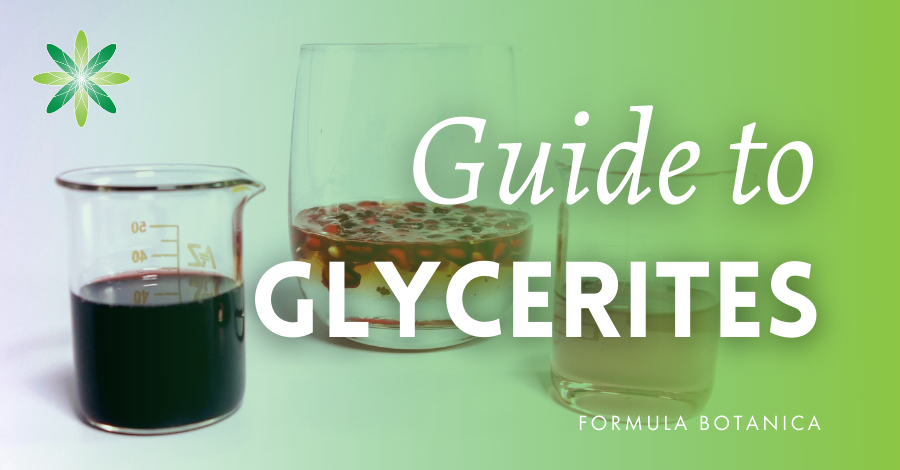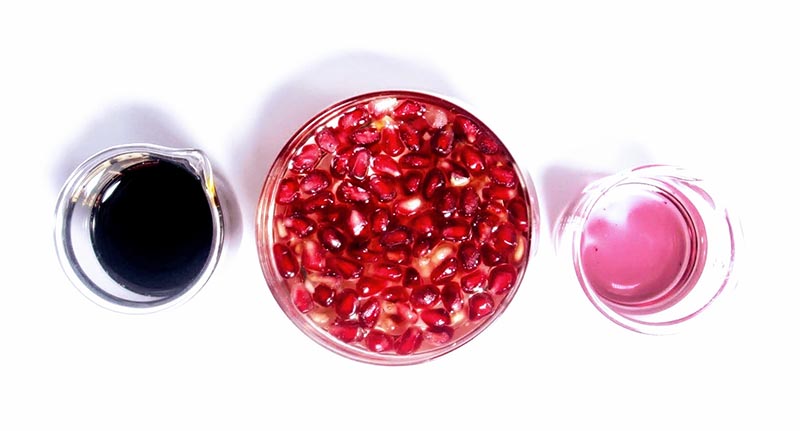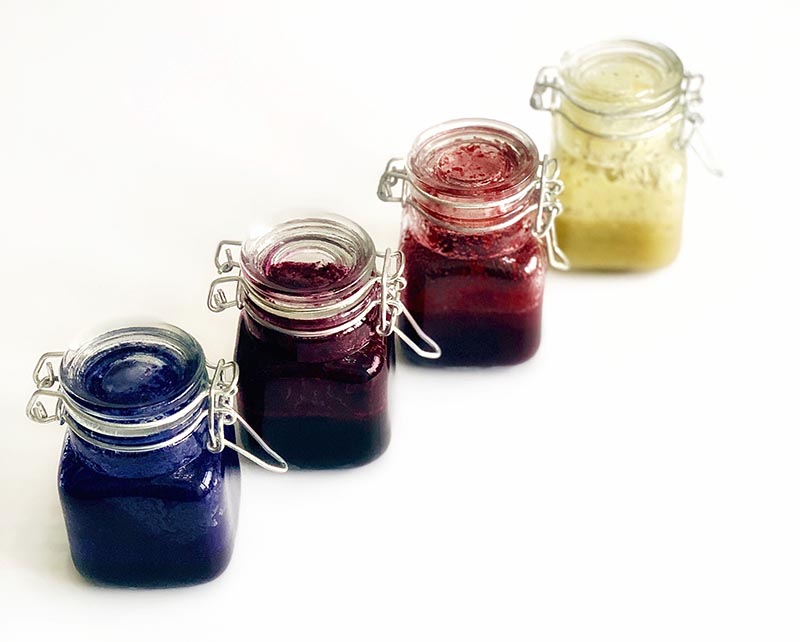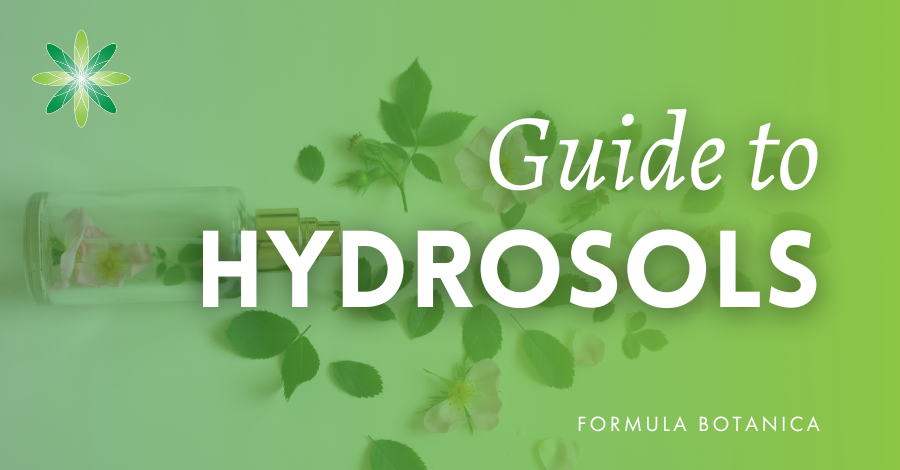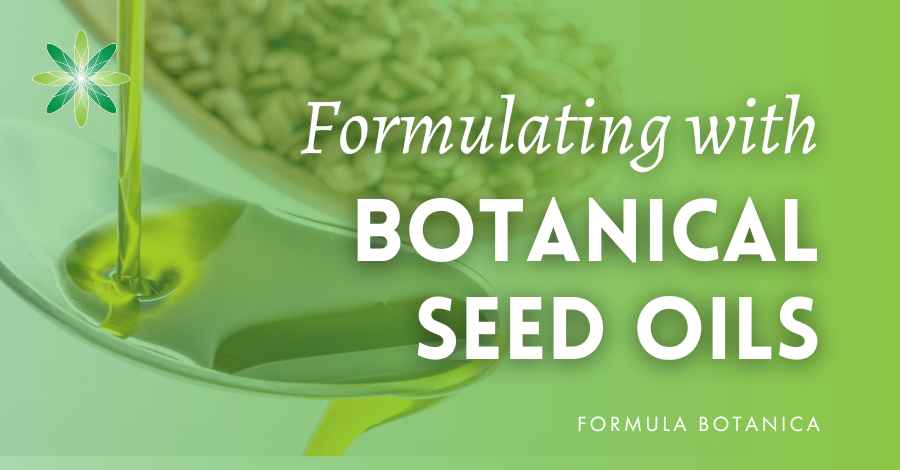Updated: 9 November, 2021.
The use of glycerites in skincare is one way to add the benefits of plants’ amazing phytochemicals – or ‘actives’ – to your natural formulations. In this guide, we give you insights and tips on starting your own journey into the fascinating and at times complex world of glycerites. If you thought glycerites were there for scent and colour alone, then read on to explore the science that makes them valued natural ingredients.
What are glycerites?
Glycerites are extracts of plant matter in glycerine. They are used extensively in herbalism as alcohol-free tinctures. Their benefit comes both from the extracts of the plant matter macerated in the glycerine and from the glycerine itself which is an excellent humectant.
Glycerine, also called glycerol, is a viscous, colourless, clear or semi-clear, non-toxic, sweet-tasting liquid produced from vegetable or animal fats. Our bodies process glycerine every time we eat fats, as these break down to fatty acids and glycerine.
It has some therapeutic properties of its own such as being soothing and a skin-conditioning agent. It is a humectant that is hygroscopic, which means it attracts water. It helps prevent water evaporation both from the skin and from the cosmetic product itself. It is therefore an important cosmetic ingredient for water retention.
Another function of glycerine is to help reduce the potential skin irritation caused by surfactants. For this reason, it is often included in formulations for products such as cleansers and shampoos.
We tend to use glycerine only in small amounts in skincare products as concentrations above 5-10 percent can give an unpleasant, undesirable sticky feel. In rinse-off cleansing products, we can use more. Toothpastes can even contain up to 50 percent glycerine.
Does glycerine hydrate the skin?
Some people think that added glycerine will provide hydration to the skin. That is technically not true, because hydration means giving water. Hydration for your skin can come from the water you drink or water in your cosmetic product. Please remember that dehydrated skin needs hydrating ingredients.
You can read more about glycerine and alternatives to glycerine as a humectant in our formulator’s guide to natural humectants.
Glycerites in skincare: make or buy them?
As formulators of skincare and/or haircare products, we usually rely on store-bought extracts. The advantage of this is that cosmetic ingredient suppliers should be able to provide us with all the necessary documentation such as the material safety data sheets (MSDS) or certificates of analysis (CoA). We need these to have our formulations undergo the tests required for us to sell our products to the public safely and legally.
If you want to make your own glycerites and then incorporate them into natural skincare products you intend to sell, expect a long and expensive journey to get all the necessary certification and analyses done. We therefore recommend buying glycerites to avoid this hassle, as well as the costs involved.
But, do not let this stop you from experimenting making botanical glycerites nor from researching the amazing benefits of herbal extracts possible to macerate into glycerine.
As natural formulators we all love getting our hands on raw botanical material often picked directly from plants we’ve grown ourselves. So, we’ve included below a short step-by-step guide to making your own glycerites for home use. First, let’s look at the science of how various solvents work in extracting phytochemicals.
How do phytochemicals dissolve in glycerine?
When making glycerites, or deciding which to buy, it would be ideal to understand which phytochemical extracts we want from a given plant and why. We may know about the properties of the plant, but what are the active compounds that provide them and in which part of the plant are they?
After doing research about the actives you are aiming to extract from a chosen plant, you can look up their solubility in Pubchem, scientific articles and pharmacognosy books. Also, by finding out which chemical class these compounds belong to you will have an idea of which solvent to use.
With these pieces of information in hand, you can make reasonable choices about which solvent is better to extract each of the plant’s interesting active compounds.
Please remember that a solvent can be anything that dissolves another thing. Water, oil, glycerine and ethanol are all solvents. Learn more about this in our guide to choosing the best herbal solvent.
Factors affecting solubility
The solubility of the phytochemicals in a given solvent depends on many factors such as:
- The affinity of the active compounds with the solvent
The simple rule of “like dissolves like” must be remembered here. Some phytochemicals might have more affinity with water, ethanol or glycerine, while others will be more easily extracted in oil.
- The pH of the solution
Some phytochemicals need to be extracted in a defined pH range to ensure they are soluble and will not be degraded in the process.
- The temperature of the solvent
– Heat might enhance the dissolution of some compounds in the chosen solvent.
– Some compounds might be heat-sensitive, therefore should be cold-processed.
– Not all solvents can be heated. Some are inflammable or can evaporate with heating.
This list is not exhaustive, but it is not meant to be as we would have to dive into chemistry to explain all the possible solubility factors. It is perfectly possible to formulate successfully with glycerites without being a chemist.
Compounds solvents may extract
Some classes of compounds that can usually be extracted in water and ethanol/glycerine solvents are:
Water
Polysaccharides (ex: gums and mucilages)
Phenolic compounds (ex: tannins)
Flavonoids (ex: anthocyanins)
Aldehydes
Ketones
Amines
Oxygen-containing compounds
Ethanol/glycerine
Sterols
Flavonoids (ex: anthocyanins)
Terpenoids
Phenolic compounds
Alkaloids
Saponins
Plants are often extracted with solvent mixtures (commonly ethanol and water), so-called hydroethanolic solvents, or combinations with glycerine or vinegar. If you come across different alcohol percentages on extracts’ labels, this is because various solvent mixtures will have a different overall polarity and will extract a different set of constituents from the plant material.
Water infusions with herbs will therefore contain different phytochemicals from that of an oil in which the same herb has been macerated.
Formula Botanica students often ask which extract is better – oil-based, water-based or glycerine-based – but this question cannot be answered easily as it depends on the herb, the solvent, the solubility of the herbs’ constituents and all the other factors mentioned above as well as the purpose of the formulation in which you wish to use the macerate.
Guide to Making your own glycerites
Earlier, we said that we recommend buying glycerites from reputable suppliers if you intend to include them in comsetics you wish to sell. But, we know that it can be rewarding and fun to make glycerites especially if you love natural, botanical ingredients and even grow plants that have properties ideal for extracting into glycerine.
Here, we give you a brief step-by-step guide to the basics of making your own glycerites. There is a lot to explore, so we recommend you do more research if you wish to take making glycerites further.
Fresh food glycerite ideas: cucumbers, strawberries, blueberries, pomegranate, papaya, red beets, lemons etc.
Herb ideas for glycerites: mallow flowers, calendula, hibiscus, rosebuds, lavender, chamomile, dandelions, elderflowers, ginger and hawthorn. Feel free to experiment.
Step-by-step guide to making your own glycerites
- Prepare your working space. It should be clean and sanitised.
- Prepare your jars, mason jars or other glass containers that must be clean and sanitised too. You can put them in the oven at any of the following temperatures and times (first having removed the insulating rubber bands):150ºC for 150 min; 160ºC for 120 min; or 170 ºC for 60 min.
- Get your herbs, plants or fruit ready. Clean and dry any outer peels and skins of fruits and vegetables thoroughly. Then, cut the botanical material into smaller pieces. For example, peel the pomegranate and get the grains out or peel or cut the cucumbers into smaller chunks. Use organic and pesticide-free fruits of good quality.
- Do not mix more than one type of botanical in a single glycerite.
- Dried herbs should be rehydrated with a small amount of distilled water.
- Resinous and mucilaginous materials are not suitable (ie. frankincense resin, chia or flax seeds).
- Weigh your ingredients and fill the jar: Up to 30 percent of raw material (or fresh herbs, or rehydrated dry herbs) and 70 percent of glycerine. Always label the container with the contents and date. Shake it.
- Leave it to infuse for 1-2 weeks shaking every so often then strain through a sieve lined with muslin or cheesecloth. Ensure that the sieve and filtration cloth are ultra clean; bear in mind this is a DIY method of making glycerites. A professional-standard, vacuum filtration method would be needed for making any glycerite aimed at commercial use. However, this equipment can be costly. Also, make sure there is no residue of botanical material in the strained glycerite.
- The shelf life is between 12-24 months. Keep your glycerite in a closed container, in a dark and cool place. Remember that a verified shelf life can only be determined through proper stability testing.
Tips on using glycerites in skincare
Glycerites can be a great addition to your water-containing formulations. Basically, you can replace glycerine with glycerites.
You can mix them with gums, for example, to thicken the product. If buying ready-made glycerites, check if they contain additional water because any extra water can cause your gum to clump. Gums blend better with pure glycerine.
Think also about the rationale of adding glycerites to rinse-off products in which they would be in contact with the skin for a very short time.
You can incorporate glycerites easily into emulsions at 2-5 percent and usually in the cool-down phase. They give your formulation the benefit of a humectant and boost it with an interesting herbal or fruit extract. The extra value will depend on the plant matter that was extracted and the compounds that will reach the skin through the medium of the glycerite.
At very low percentages, the glycerite is unlikely to cause intense colour change of emulsions. They can have an effect on the colour in gels though.
We always recommend performing stability testing on your product to see whether the colour and scent stay the same.
You may wish to add glycerites to anhydrous products. In this case, a tiny amount could blend in quite well, but consider the hygroscopic nature of glycerine: it absorbs water from the environment. An anhydrous product containing glycerine that is left open in a humid bathroom would attract moisture and consequently would end up as a bacteria feast if no preservative were added.
When buying glycerites that contain water and preservatives, check which preservative(s). You may find some preservatives, such as Leucidal liquid, are cationic and as such they may interfere with Xanthan gum or other anionic ingredients added to the formula.
We hope this guide to using glycerites in skincare has given you some insights into how to formulate with glycerites. As you can see, there is plenty to learn about the extraction of phytochemicals into solvents, of which glycerine is one option. We encourage you to research further so you can use glycerites in skincare to best effect.
Suggested suppliers
Most larger cosmetics’ ingredients suppliers offer some glycerites, but here are a few suggestions:
UK/EU:
Aromantic – Pomegranate glycerol extract and Cucumber glycerol extract
USA: Formulator Sample Shop – Hibiscus extract
FREE TRAINING
Learn how to become an
Organic Skincare Formulator
FREE TRAINING
How to become an
Organic Skincare Entrepreneur
FREE TRAINING
How to become an
Organic Skincare Entrepreneur
Leave us a comment

Barbora Harmatova is a Formulator as well as a Tutor at Formula Botanica, where she helps our students to become better organic cosmetic formulators. Read more about the Formula Botanica Team.

